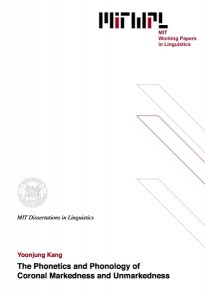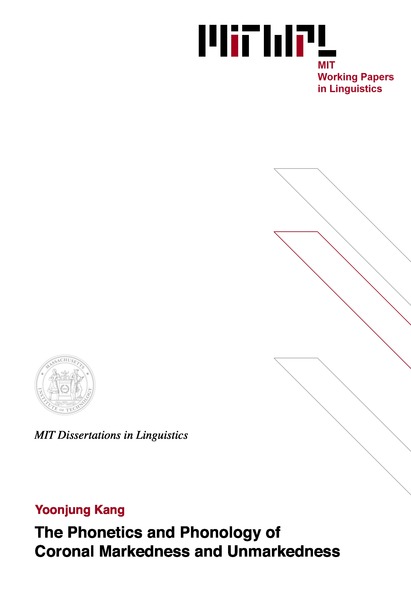The Phonetics and Phonology of Coronal Markedness and Unmarkedness
Y. Kang, 2000
This thesis investigates place feature restrictions in oral and nasal stop consonants with a special focus on the asymmetrical behavior of coronal and noncoronal stops. Two conflicting patterns of place restriction in outputs are attested; coronal unmarkedness and coronal markedness. This thesis shows that coronal unmarkedness is truly a default pattern of place restriction. Coronal unmarkedness is not confined to specific segmental contexts or to languages with a particular inventory structure. In addition, the coronal unmarked pattern is attested through diverse phonological processes such as assimilation, place neutralization, segmental and featural deletion, metathesis, vowel syncope and morpheme structure constraints. This follows from the context-free place markedness hierarchy proposed by Prince and Smolensky (1993). These constraints can conjoin freely with any context-specific constraints. Such conjunction predicts neutralization to coronal place to be attested in any position where place contrast reduction is found. On the other hand, although coronal markedness is also attested through diverse phonological processes such as assimilation, place neutralization, segmental and featural deletion, metathesis and morpheme structure constraints, it is found only in nonprevocalic positions and only in languages without a sub-coronal place contrast. I propose that unlike the default markedness constraint hierarchy, the reversed markedness hierarchy is projected from a perceptibility scale of place features and is therefore context-specific. I argue that a coronal stop in nonprevocalic position in a single-coronal language is perceptually less salient than noncoronal stops in corresponding positions due to a preferential weakening of tongue body articulation for coronal stops in these positions. Also discussed in this thesis is the effect of nasality of stops on the degree of place restrictions. A nasal stop tends to allow fewer place contrasts than an oral stop and a stop followed by an oral stop tends to allow fewer place contrasts than one followed by a nasal stop. Finally, previous approaches to coronal versus noncoronal asummetry " Coronal Underspecification, Underspecification by Constraints and Perceptually Grounded Faithfulness Constraints " are discussed and their inadequacy is demonstrated.
Thesis Supervisors: Michael Kenstowicz, Cheryl Zoll
Titles: Professor of Linguistics, Associate Professor of Linguistics
Table of Contents
Chapter 1 Introduction 11
Chapter 2 Coronal Markedness: Phonetic Grounding 19
2.1 Markedness reversal: overview 19
2.2 Sub-coronal contrast and contrastive specification 25
2.3 No contrast and no vocalic release: conditions of markedness
reversal 31
2.3.1 Nonprevocalic position as locus of articulatory weakening 32
2.3.2 The tongue body gesture in coronal stop articulation 37
2.3.3 Lack of sub-coronal contrast as a condition of articulatory
weakening 42
Chapter 3 Coronal Markedness: Data and Analyses 47
3.1 Place assimilation 47
3.1.1 Data 48
3.1.2 Analyses 55
3.2 Deletion 58
3.2.1 Data 58
3.2.2 Analyses 63
3.3 Metathesis 65
3.4 Morpheme Structure Constraints 76
3.5 Nasality and place cues 79
3.5.1 Internal context: nasal versus oral asymmetry 81
3.5.1.1 Background 81
3.5.1.2 Data 82
3.5.1.3 Analyses 87
3.5.2 External context: nasal versus oral asymmetry 97
3.5.2.1 Background 97
3.5.2.2 Cebuano Bisayan and Moa 99
3.5.2.3 Additional cases: Attic Greek and English 103
Chapter 4 Coronal Unmarkedness 109
4.1 Context-free coronal unmarkedness 110
4.1.1 Inventory generalizations 110
4.1.2 Epenthesis 112
4.1.3 Coronal transparency 114
4.1.4 The Obligatory Contour Principle 119
4.2 Coronal unmarkedness: nonprevocalic position 122
4.2.1 Nonprevocalic position as the locus of place contrast
reduction 123
4.2.2 Sub-coronal place contrasts and coronal unmarkedness 126
4.2.2.1 Deletion 126
4.2.2.2 Place assimilation 130
4.2.2.3 Syncope 138
4.2.2.4 Morpheme Structure Constraints 141
4.2.3 No sub-place contrast and coronal unmarkedness 143
4.2.3.1 Place Assimilation 144
4.2.3.2 Deletion (Place neutralization) 147
4.2.3.3 Metathesis 149
4.2.3.4 Morpheme Structure Constraints 152
4.2.4 Nasality and coronal unmarkedness: the case of Finnish 154
Chapter 5 Previous Approaches 171
5.1 The coronal underspecification approach 173
5.2 The underspecfication by constraint approach 178
5.3 The perceptually motivated faithfulness constraint approach 185
Chapter 6 Conclusion 189

